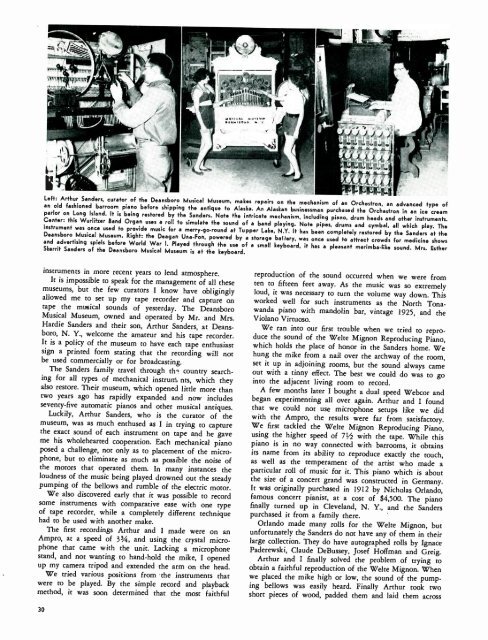Tape Recording Magazine - AmericanRadioHistory.Com
Tape Recording Magazine - AmericanRadioHistory.Com
Tape Recording Magazine - AmericanRadioHistory.Com
Create successful ePaper yourself
Turn your PDF publications into a flip-book with our unique Google optimized e-Paper software.
Left: Arthur Sanders, curator of the Deansboro Musical Museum, makes repairs on the mechanism of an Orchestron, an advanced type of<br />
an old fashioned barroom piano before shipping the antique fo Alaska. An Alaskan businessman purchased the Orchestron in an ice cream<br />
parlor on Long Island. It is being restored by the Sanders. Note the intricate mechanism, including piano, drum heads and other instruments.<br />
Center: this Wurlitzer Band Organ uses a roll to simulate the sound of a band playing. Note pipes, drums and cymbal, all which play. The<br />
instrument was once used to provide music for a<br />
merry -go -round at Tupper Lake, N.Y. It has been<br />
Deansboro<br />
completely<br />
Musical<br />
restored<br />
Museum.<br />
by the<br />
Right:<br />
Sanders<br />
the Deagan<br />
at the<br />
Una -Fon, powered by a storage battery, was once used fo attract crowds for medicine shows<br />
and advertising spiels before World War I. Played through the use of a<br />
Skerrit Sanders of the Deansboro Musical Museum is at the keyboard.<br />
small keyboard, it has a pleasant marimba -like sound. Mrs. Esther<br />
instruments in more recent years to lend atmosphere.<br />
It is impossible to speak for the management of all these<br />
museums, but the few curators I know have obligingly<br />
allowed me to set up my tape recorder and capture on<br />
tape the musical sounds of yesterday. The Deansboro<br />
Musical Museum, owned and operated by Mr. and Mrs.<br />
Hardie Sanders and their son, Arthur Sanders, at Deans -<br />
boro, N. Y., welcome the amateur and his tape recorder.<br />
It is a policy of the museum to have each tape enthusiast<br />
sign a printed form stating that the recording will not<br />
be used commercially or for broadcasting.<br />
The Sanders family travel through th- country searching<br />
for all types of mechanical instrum nts, which they<br />
also restore. Their museum, which opened little more than<br />
two years ago has rapidly expanded and now includes<br />
seventy-five automatic pianos and other musical antiques.<br />
Luckily, Arthur Sanders, who is the curator of the<br />
museum, was as much enthused as I in trying to capture<br />
the exact sound of each instrument on tape and he gave<br />
me his wholehearted cooperation. Each mechanical piano<br />
posed a challenge, not only as to placement of the microphone,<br />
but to eliminate as much as possible the noise of<br />
the motors that operated them. In many instances the<br />
loudness of the music being played drowned out the steady<br />
pumping of the bellows and rumble of the electric motor.<br />
We also discovered early that it was possible to record<br />
some instruments with comparative ease with one type<br />
of tape recorder, while a completely different technique<br />
had to be used with another make.<br />
The first recordings Arthur and I made were on an<br />
Ampro, at a speed of 33/, and using the crystal microphone<br />
that came with the unit. Lacking a microphone<br />
stand, and not wanting to hand -hold the mike, I opened<br />
up my camera tripod and extended the arm on the head.<br />
We tried various positions from the instruments that<br />
were to be played. By the simple record and playback<br />
method, it was soon determined that the most faithful<br />
reproduction of the sound occurred when we were from<br />
ten to fifteen feet away. As the music was so extremely<br />
loud, it was necessary to turn the volume way down. This<br />
worked well for such instruments as the North Tonawanda<br />
piano with mandolin bar, vintage 1925, and the<br />
Violano Virtuoso.<br />
We ran into our first trouble when we tried to reproduce<br />
the sound of the Weite Mignon Reproducing Piano,<br />
which holds the place of honor in the Sanders home. We<br />
hung the mike from a nail over the archway of the room,<br />
set it up in adjoining rooms, but the sound always came<br />
out with a tinny effect. The best we could do was to go<br />
into the adjacent living room to record.<br />
A few months later I bought a dual speed Webcor and<br />
began experimenting all over again. Arthur and I found<br />
that we could not use microphone setups like we did<br />
with the Ampro, the results were far from satisfactory.<br />
We first tackled the Welte Mignon Reproducing Piano,<br />
using the higher speed of 71/2 with the tape. While this<br />
piano is in no way connected with barrooms, it obtains<br />
its name from its ability to reproduce exactly the touch,<br />
as well as the temperament of the artist who made a<br />
particular roll of music for it. This piano which is about<br />
the size of a concert grand was constructed in Germany.<br />
It was originally purchased in 1912 by Nicholas Orlando,<br />
famous concert pianist, at a cost of $4,500. The piano<br />
finally turned up in Cleveland, N. Y., and the Sanders<br />
purchased it from a family there.<br />
Orlando made many rolls for the Wette Mignon, but<br />
unfortunately the Sanders do not have any of them in their<br />
large collection. They do have autographed rolls by Ignace<br />
Paderewski, Claude DeBussey, Josef Hoffman and Greig.<br />
Arthur and I finally solved the problem of trying to<br />
obtain a faithful reproduction of the Welte Mignon. When<br />
we placed the mike high or low, the sound of the pumping<br />
bellows was easily heard. Finally Arthur took two<br />
short pieces of wood, padded them and laid them across<br />
30
















